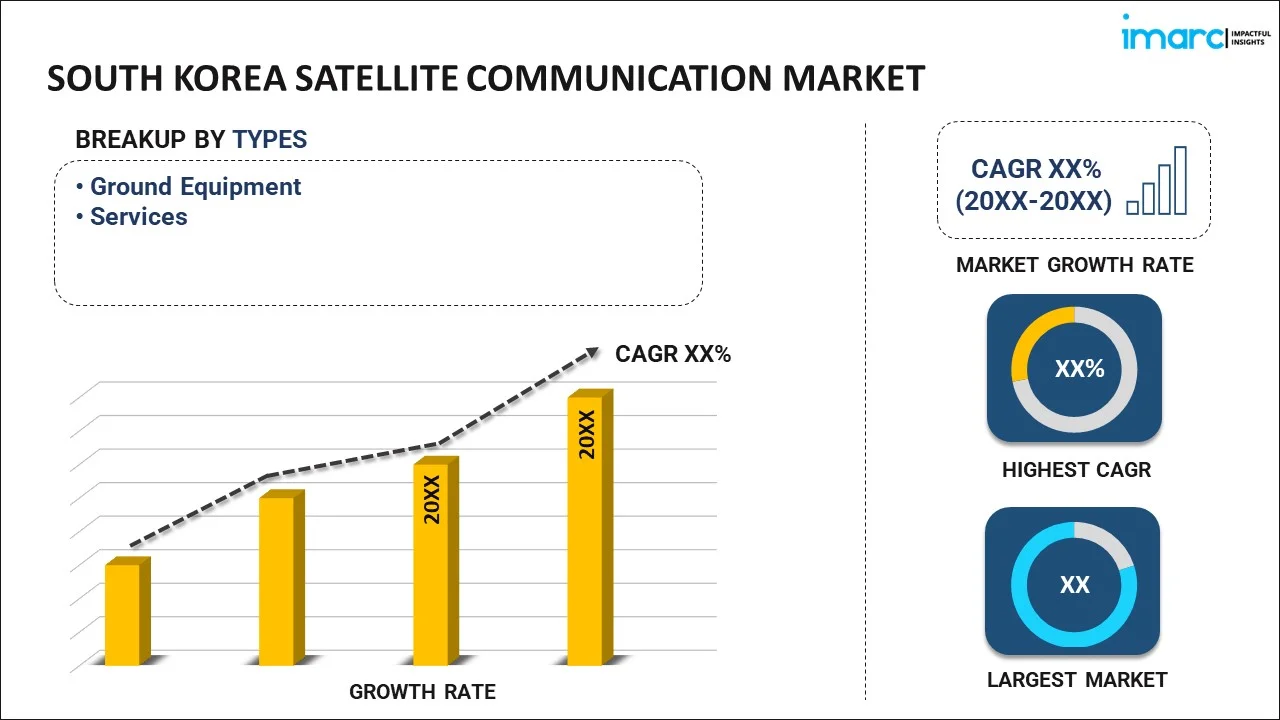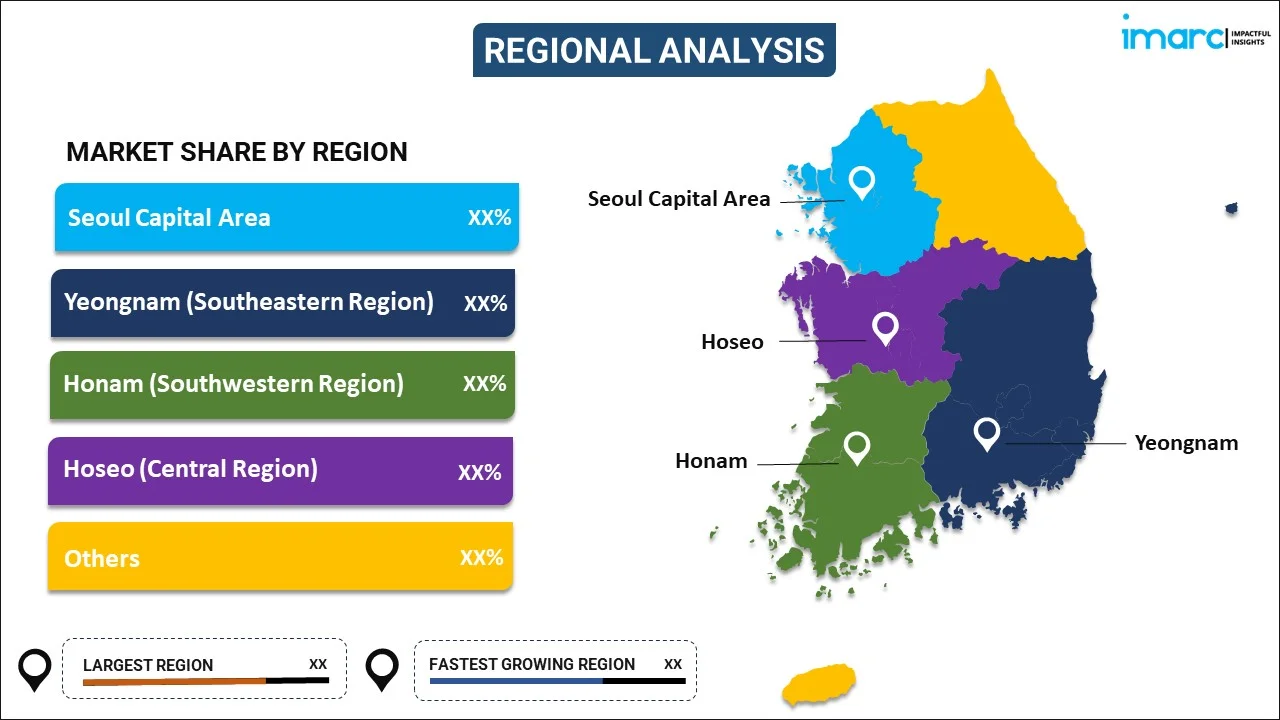
South Korea Satellite Communication Market Report by Type (Ground Equipment, Services), Platform (Portable, Land, Maritime, Airborne), End User (Maritime, Defense and Government, Enterprises, Media and Entertainment, and Others), and Region 2026-2034
Market Overview:
South Korea satellite communication market size reached USD 1.9 Billion in 2025. Looking forward, IMARC Group expects the market to reach USD 3.7 Billion by 2034, exhibiting a growth rate (CAGR) of 7.90% during 2026-2034. The increasing demand for high-speed internet, rapid expansion of fifth-generation (5G) network, favorable government initiatives, surging space exploration endeavors, escalating disaster management needs, and rising defense sector reliance on satellite communication are some of the key factors fueling the market growth.
|
Report Attribute
|
Key Statistics
|
|---|---|
|
Base Year
|
2025 |
|
Forecast Years
|
2026-2034
|
|
Historical Years
|
2020-2025
|
| Market Size in 2025 | USD 1.9 Billion |
| Market Forecast in 2034 | USD 3.7 Billion |
| Market Growth Rate (2026-2034) | 7.90% |
Access the full market insights report Request Sample
Satellite communication is a sophisticated system that relies on the use of artificial satellites positioned in geostationary or low Earth orbit to facilitate the transmission of data, voice, and video signals across the globe. It functions through the transmission and reception of electromagnetic signals. In this process, ground stations send information to satellites in space, which boosts and send it back to Earth. This enables long-distance communication without the need for physical infrastructure such as cables or wires. The technology works on the principle of line-of-sight, meaning that for effective communication, the transmitter and receiver must have an unobstructed view of the satellite. Satellite communication offers numerous advantages, such as it provides global coverage, reaching remote and isolated areas that are challenging to connect through terrestrial networks. Additionally, it offers high data transmission rates, making it suitable for broadcasting television signals, internet access, and real-time voice communication. Moreover, satellite systems are highly reliable, as they are less vulnerable to natural disasters or physical disruptions that can affect ground-based infrastructure. This reliability makes them an essential tool for emergency services and disaster management. Furthermore, satellite networks are easily scalable, allowing for increased capacity to accommodate growing communication needs.
South Korea Satellite Communication Market Trends:
The South Korea satellite communication market is influenced by several key drivers, such as the increasing demand for high-speed internet connectivity in both urban and rural areas. This is further supported by the expansion of the 5G network infrastructure and the need for reliable backhaul solutions. Additionally, the government's initiatives to promote satellite technology adoption, such as the Korean Multi-Functional Satellite program, serve as a catalyst for market expansion. Moreover, the growing interest in satellite-based broadcasting services, including direct-to-home (DTH) television, fuels the market growth. In line with this, the rising number of satellite launches by South Korean companies and partnerships with international players reflect the nation's commitment to space exploration and satellite technology, which is propelling the market growth. Furthermore, the commercialization of satellite imagery services for agriculture, forestry, and environmental monitoring and the maritime industry's reliance on satellite communication for vessel tracking and safety contribute to the market growth. Apart from this, the development of advanced satellite technology, such as high-throughput satellites, and the defense sector's increasing reliance on satellite communication for secure and uninterrupted communication are accelerating the market growth across the country.
South Korea Satellite Communication Market Segmentation:
IMARC Group provides an analysis of the key trends in each segment of the market, along with forecasts at the country level for 2026-2034. Our report has categorized the market based on type, platform, and end user.
Type Insights:

To get detailed segment analysis of this market Request Sample
- Ground Equipment
- Services
The report has provided a detailed breakup and analysis of the market based on the type. This includes ground equipment and services.
Platform Insights:
- Portable
- Land
- Maritime
- Airborne
A detailed breakup and analysis of the market based on the platform have also been provided in the report. This includes portable, land, maritime, and airborne.
End User Insights:
- Maritime
- Defense and Government
- Enterprises
- Media and Entertainment
- Others
The report has provided a detailed breakup and analysis of the market based on the end user. This includes maritime, defense and government, enterprises, media and entertainment, and others.
Regional Insights:

To get detailed regional analysis of this market Request Sample
- Seoul Capital Area
- Yeongnam (Southeastern Region)
- Honam (Southwestern Region)
- Hoseo (Central Region)
- Others
The report has also provided a comprehensive analysis of all the major regional markets, which include Seoul Capital Area, Yeongnam (Southeastern Region), Honam (Southwestern Region), Hoseo (Central Region), and Others.
Competitive Landscape:
The market research report has also provided a comprehensive analysis of the competitive landscape in the market. Competitive analysis such as market structure, key player positioning, top winning strategies, competitive dashboard, and company evaluation quadrant has been covered in the report. Also, detailed profiles of all major companies have been provided.
South Korea Satellite Communication Market Report Coverage:
| Report Features | Details |
|---|---|
| Base Year of the Analysis | 2025 |
| Historical Period | 2020-2025 |
| Forecast Period | 2026-2034 |
| Units | Billion USD |
| Scope of the Report | Exploration of Historical Trends and Market Outlook, Industry Catalysts and Challenges, Segment-Wise Historical and Future Market Assessment:
|
| Types Covered | Ground Equipment, Services |
| Platforms Covered | Portable, Land, Maritime, Airborne |
| End Users Covered | Maritime, Defense and Government, Enterprises, Media and Entertainment, Others |
| Regions Covered | Seoul Capital Area, Yeongnam (Southeastern Region), Honam (Southwestern Region), Hoseo (Central Region), Others |
| Customization Scope | 10% Free Customization |
| Post-Sale Analyst Support | 10-12 Weeks |
| Delivery Format | PDF and Excel through Email (We can also provide the editable version of the report in PPT/Word format on special request) |
Key Questions Answered in This Report:
- How has the South Korea satellite communication market performed so far and how will it perform in the coming years?
- What has been the impact of COVID-19 on the South Korea satellite communication market?
- What is the breakup of the South Korea satellite communication market on the basis of type?
- What is the breakup of the South Korea satellite communication market on the basis of platform?
- What is the breakup of the South Korea satellite communication market on the basis of end user?
- What are the various stages in the value chain of the South Korea satellite communication market?
- What are the key driving factors and challenges in the South Korea satellite communication?
- What is the structure of the South Korea satellite communication market and who are the key players?
- What is the degree of competition in the South Korea satellite communication market?
Key Benefits for Stakeholders:
- IMARC’s industry report offers a comprehensive quantitative analysis of various market segments, historical and current market trends, market forecasts, and dynamics of the South Korea satellite communication market from 2020-2034.
- The research report provides the latest information on the market drivers, challenges, and opportunities in the South Korea satellite communication market.
- Porter's five forces analysis assist stakeholders in assessing the impact of new entrants, competitive rivalry, supplier power, buyer power, and the threat of substitution. It helps stakeholders to analyze the level of competition within the South Korea satellite communication industry and its attractiveness.
- Competitive landscape allows stakeholders to understand their competitive environment and provides an insight into the current positions of key players in the market.
Need more help?
- Speak to our experienced analysts for insights on the current market scenarios.
- Include additional segments and countries to customize the report as per your requirement.
- Gain an unparalleled competitive advantage in your domain by understanding how to utilize the report and positively impacting your operations and revenue.
- For further assistance, please connect with our analysts.
 Request Customization
Request Customization
 Speak to an Analyst
Speak to an Analyst
 Request Brochure
Request Brochure
 Inquire Before Buying
Inquire Before Buying




.webp)




.webp)












